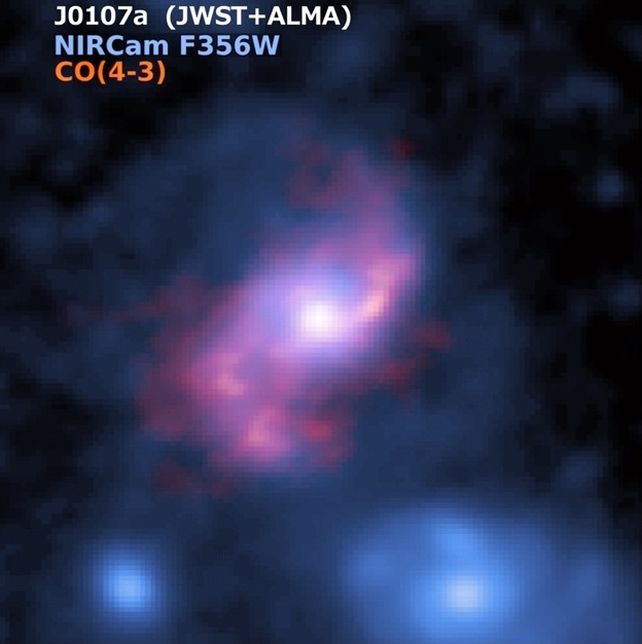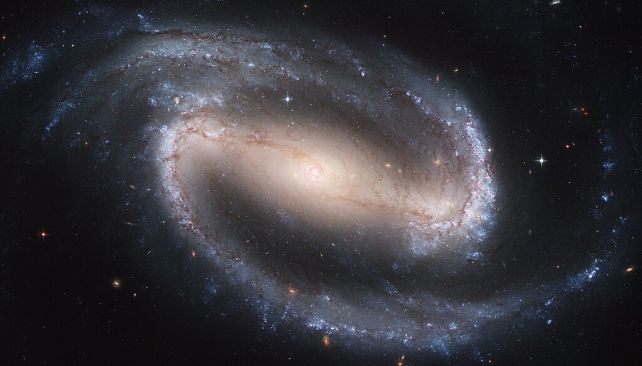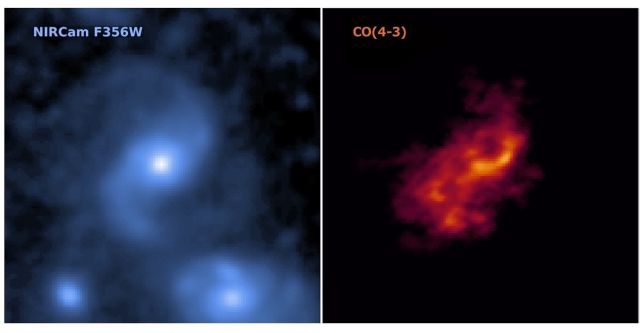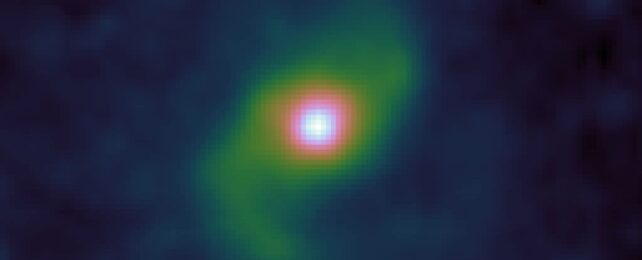The mystery of galaxies in the early Universe just got even weirder.
A team of astronomers has identified a giant spiral galaxy so well-formed that it already has a stable galactic bar; a long, straight structure filled with stars across the galaxy's center. It was formed just 2.6 billion years after the Big Bang.
It's not the first galactic bar to be identified in the first three billion years of the Universe's lifespan… but it's the first to be analyzed in detail, revealing some surprising similarities between galaxies that have had much more time to evolve, while compounding the question of how galaxies formed during the Universe's infancy.
"The most surprising thing is the similarity with local galaxies," astronomer Shuo Huang of the National Astronomical Observatory of Japan told ScienceAlert.
"We proposed ALMA [Atacama Large Millimetre/submillimetre Array] observations to see whether the bar of J0107a is channeling gas inward to feed the central starburst, but did not expect the gas distribution and motion can in a way look just like present-day galaxies. This means the galaxy structure formed faster than we thought."

Recently, there's been a huge escalation in the number of large spiral galaxies discovered in the early Universe, posing a significant problem for our understanding of how the early Universe evolved. We thought the process was slower, starting with a black hole around which gas gradually accumulated, growing dense enough to begin forming stars.
Once the growing galaxy is large enough, it will start to gravitationally arrange itself into the spiral structures we see around us in the local Universe, including our own Milky Way. The central galactic bar is a highly evolved and organized part of the architecture of a galaxy, and therefore is thought to be a feature of the more mature examples.
In addition, bars – which act as conduits driving gas flows towards the galactic center – are fairly vulnerable to disruption, and even an interaction with a passing galaxy, let alone a galactic collision, can hinder their development.

In 2023, Huang and his colleagues described a galaxy called J0107a based on data from JWST, the Chandra X-ray Observatory, and ALMA. This thing is a beast. It's a beautifully formed grand design spiral galaxy with 450 billion solar masses' worth of stars, positively bursting with star formation at a rate of 500 solar masses per year.
Huang's team wanted to understand the evolution of J0107a, so they used JWST and ALMA observations to try to map the movements of the gas therein. What they found was a shock: the galaxy's bar is shunting gas to the galaxy's center at a rate of around 600 solar masses per year, fueling the high rate of star formation found there.
This star gas flow is occurring in J0107a around 10 to 100 times faster than it does in galaxies we see around us in the local Universe, including the Milky Way. It feeds into the galactic center, increasing in density as it accumulates there. Since stars form from dense knots in thick clouds of gas and dust, the flows do indeed facilitate star birth. This suggests that bars may have been an important driver of galactic growth and evolution earlier than we had thought possible.

For every answer, however, more questions inevitably emerge.
"We have shown that the gas motion and distribution are very similar to local galaxies, but whether stars form from the gas in the same way is not clear," Huang said. "The gas is much denser than that in local galaxies. Star formation is sensitive to gas density, so it might happen somewhere that local galaxies do not form stars."
The discovery also means we might need to rethink our models of early galactic evolution. One means by which galaxies can grow is by merging with other galaxies. The presence of a stable bar suggests that J0107a has been hanging around unperturbed for quite some time.

The researchers therefore believe that the galaxy rapidly formed directly from gas fed by the cosmic web that spans across intergalactic space.
"We are interested in the existence of such a large galaxy with a local-like shape just 2.6 billion years after the Big Bang," Huang said.
"A possible answer is that a large amount of gas inflow from the cosmic web formed a giant disk. How the cosmic gas stream arrives in the galaxy and settles down to make a disk is an open question in observational astronomy. The theoretical predictions have not been directly observed yet."
Future observations of the galaxy, the researchers hope, will help solve these baffling puzzles.
The research has been published in Nature.
